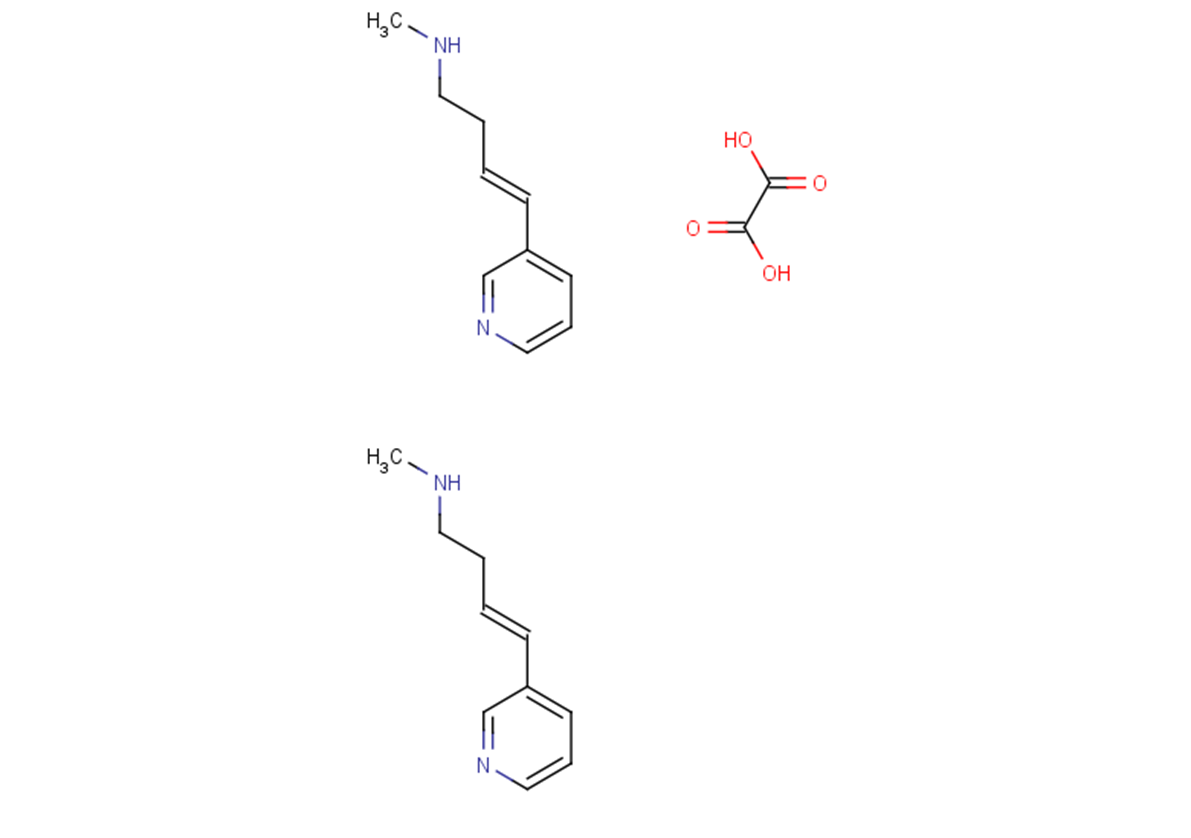Powder: -20°C for 3 years | In solvent: -80°C for 1 year


Rivanicline hemioxalate, also known as RJR-2403 hemioxalate or (E)-Metanicotine hemioxalate, is a chemical compound acting as a neuronal nicotinic receptor agonist with pronounced selectivity for the α4β2 receptor subtype, showing over 1,000-fold greater selectivity for this subtype (Ki=26 nM) compared to α7 receptors (Ki=3.6 μM). Its in vitro studies demonstrate no significant activation of nAChRs in PC12 cells, muscle type nAChRs, or muscarinic receptors at concentrations up to 1 mM. Furthermore, Rivanicline displayed less than one-tenth the potency of nicotine in inducing ileum contraction, with substantially lower efficacy, and failed to antagonize nicotine-induced stimulation of muscle or ganglionic nAChR functions, with an IC50 value greater than 1 mM. Chronic exposure to Rivanicline at 10 microM led to up-regulation of high-affinity nAChRs in M10 cells, mimicking effects observed with nicotine. In vivo studies revealed that Rivanicline significantly reversed scopolamine-induced amnesia and improved working and reference memory in a rat model, while being 15 to 30 times less potent than nicotine in affecting body temperature, respiration, and other physiological responses. Metanicitone’s potency was approximately five times lower than nicotine in tail-flick tests following subcutaneous administration, yet slightly more potent upon central administration.

| Pack Size | Availability | Price/USD | Quantity |
|---|---|---|---|
| 500 mg | 10-14 weeks | $ 1,774.00 |
| Description | Rivanicline hemioxalate, also known as RJR-2403 hemioxalate or (E)-Metanicotine hemioxalate, is a chemical compound acting as a neuronal nicotinic receptor agonist with pronounced selectivity for the α4β2 receptor subtype, showing over 1,000-fold greater selectivity for this subtype (Ki=26 nM) compared to α7 receptors (Ki=3.6 μM). Its in vitro studies demonstrate no significant activation of nAChRs in PC12 cells, muscle type nAChRs, or muscarinic receptors at concentrations up to 1 mM. Furthermore, Rivanicline displayed less than one-tenth the potency of nicotine in inducing ileum contraction, with substantially lower efficacy, and failed to antagonize nicotine-induced stimulation of muscle or ganglionic nAChR functions, with an IC50 value greater than 1 mM. Chronic exposure to Rivanicline at 10 microM led to up-regulation of high-affinity nAChRs in M10 cells, mimicking effects observed with nicotine. In vivo studies revealed that Rivanicline significantly reversed scopolamine-induced amnesia and improved working and reference memory in a rat model, while being 15 to 30 times less potent than nicotine in affecting body temperature, respiration, and other physiological responses. Metanicitone’s potency was approximately five times lower than nicotine in tail-flick tests following subcutaneous administration, yet slightly more potent upon central administration. |
| Synonyms | RJR-2403 hemioxalate, (E)-Metanicotine hemioxalate |
| Molecular Weight | 207.23 |
| Formula | C12H16N2O4 |
| CAS No. | T12738 |
Powder: -20°C for 3 years | In solvent: -80°C for 1 year
DMSO: 50 mg/mL (241.28 mM), Sonication is recommended.
You can also refer to dose conversion for different animals. More
bottom
Please see Inhibitor Handling Instructions for more frequently ask questions. Topics include: how to prepare stock solutions, how to store products, and cautions on cell-based assays & animal experiments, etc.
Rivanicline hemioxalate T12738 Others RJR2403 Hemioxalate Metanicotine Hemioxalate Metanicotine RJR-2403 RJR-2403 Hemioxalate RJR2403 RJR 2403 RJR-2403 hemioxalate Rivanicline Hemioxalate RJR 2403 Hemioxalate Rivanicline (E)-Metanicotine hemioxalate inhibitor inhibit
